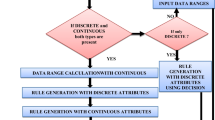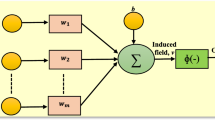Abstract
The neural networks are successfully applied to many applications in different domains. However, due to the results made by the neural networks are difficult to explain the decision process of neural networks is supposed as a black box. The explanation of reasoning is important to some applications such like credit approval application and medical diagnosing software. Therefore, the rule extraction algorithm is becoming more and more important in explaining the extracted rules from the neural networks. In this paper, a decompositional algorithm is analyzed and designed to extract rules from neural networks. The algorithm is simple but efficient; can reduce the extracted rules but improve the efficiency of the algorithm at the same time. Moreover, the algorithm is compared to the other two algorithms, M-of-N and Garcez, by solving the MONK’s problem.




Similar content being viewed by others
References
Tickle AB, Andrews R, Golea M, Diederich J (1968) The truth will come to light: directions and challenges in extracting the knowledge embedded within trained artificial neural networks. IEEE Trans Neural Netw 9(6):1057–1068
d’Avila Garcez AS, Broda K, Gabbay DM (2001) Symbolic knowledge extraction from trained neural networks: a sound approach. Artif Intell 125:155–207
Pop E, Hayward R, Diedrich A (1994) RULENEG: extracting rules from a trained neural network using stepwise negation, Technical Report, (Neurocomputing Research Centre, Queensland University of Technology, 1994)
Towell GG, Shavlik JW (1993) The extraction of refined rules from knowledge-based neural networks. Mach Learn 13:71–101
Towell GG, Shavlik JW (1994) Knowledge-based artificial neural networks. Artif Intell 70:119–165
Tsukimoto H (2000) Extracting rules from trained neural networks. IEEE Trans Neural Netw 11(2):377–389
Freeman JA, Skapura DM (1992) Neural networks. Addison-Wesley, Reading
Fu LM (1994) Rule generation from neural networks. IEEE Trans Syst Man Cybern 28(8):1114–1124
Pratt LY, Mostow J, Kamm CA (1991) Direct transfer of learned information among neural networks. In: Proceedings of the 9th National Conference on Artificial Intelligence. Anaheim, pp 584–589
Craven MW, Shavlik JW (1994) Using sampling and queries to extract rules from trained neural networks. In: Proceedings of the 11th International Conference on Machine Learning. New Brunswick, pp 37–45
Jackson P (1999) Introduction to expert systems. Addison-Wesley, Reading
Andrews R, Diederich J, Tickle AB (1995) Survey and critique of techniques for extracting rules from trained artificial neural networks. Knowl Base Syst 8(6):373–389
Andrews R, Geva S (1995) Inserting and extracting knowledge from constrained error back propagation networks. In: Proceedings of the 6th Australian Conference on Neural Networks. Sydney
Andrews R, Geva S (2002) Rule extraction from local cluster neural nets. Neuro Comput 47:1–20
Setiono R (1997) A penalty function approach for pruning feedforward neural networks. Neural Comput 9(1):185–204
Setiono R (1997) Extracting rules from neural networks by pruning and hidden-unit splitting. Neural Comput 9(1):205–225
Thrun SB, et al. (1991) The MONK’s problems: a performance comparison of different learning algorithms, Technical Report CMU-CS-91-197. Carnegie Mellon University
Thrun SB (1994) Extracting provably correct rules from artificial neural networks, Technical Report IAI-TR-93-5. Institut für Informatik III, University of Bonn, Germany
Naturopathic association (1999) Naturopathy of coronary artery disease. Chinese edn. Ye-He Publishing
Chen JC, Liu TS, Weng CS, Heh JS (2005) An expert system of coronary artery disease in Chinese and western medicine. In: Proceedings of the 6th Asian–Pacific conference on medical and biological engineering. Tsukuba
Pham DT, Salem Z (2004) A new technique for rule pruning in machine learning, In: International conference on information and communication technologies: from theory to applications. Damascus, pp 437–438
Chang M, Chen JC, Chang JW, Heh JS (2006) Advanced process control expert system of CVD membrane thickness based on neural network. Material Science Forum, pp 505–507, 313–318
Krishnan R, Sivakumar G, Bhattacharya P (1999) A search technique for rule extraction from trained neural networks. Pattern Recognit Lett 20:273–280
Taha IA, Ghosh J (1999) Symbolic interpretation of artificial neural networks. IEEE Trans Knowl Data Eng 11(3):448–463
Chen JC, Heh JS, Chang M (2006) Designing A Decompositional Rule Extraction Algorithm for Neural Networks. Lect Notes Comput Sci 3971:1305–1311
Chang M, Chen JC, Heh J (2006) The control of membrane thickness in Pecvd process utilizing a rule extraction technique of neural networks. Lect Notes Comput Sci 3973:1091–1098
Chen JC, Chang M, Chu KK (2006) Representing the abnormal Web access for advertisement counting based on the rule-extraction mechanism of neural networks. In: Proceedings of the 8th International conference on artificial intelligence and soft computing. Zakopane
Takagi T, Sugeno M (1985) Fuzzy identification of system and its applications to modeling and control. IEEE Trans Syst Man Cybern 15(0):116–132
Roger Jang JS, Sun CT (1993) Functional equivalence between radial basis function networks and fuzzy inference systems. IEEE Trans Neural Netw 4:156–158
Leng G, McGinnity TM, Prasad G (2005) An approach for on-line extraction of fuzzy rules using a self-organising fuzzy neural network. Fuzzy Sets Syst 150:211–243
McGarry KJ, Wermter S, MacIntyre J (2001) Knowledge extraction from local function networks. In: Proceedings of the 17th international joint conference on artificial intelligence. Seattle
Ultsch A, Halmans G, Mantyk R (1991) CONKAT: a connectionist knowledge acquisition tool. In: Proceedings of the 24th Hawaii IEEE International Conference on System Sciences, Hawaii
Castellano G, Fanelli AM, Mencar C (2005) A neuro-fuzzy network to generate human-understandable knowledge from data. Cogn Syst Res 3:125–144
Malone J, McGarry KJ, Bowerman C, Wermter S (2006) Rule extraction from Kohonen neural networks. Neural Comput Appl J 15(1):9–17
Jeff Schlimmer (1984) United States congressional voting records database, Congressional Quarterly Almanac, 98th Congress, 2nd session 1984, vol XL. Congressional Quarterly Inc., Washington, DC
Jeff Schlimmer (1987) Concept acquisition through representational adjustment, Doctoral dissertation. Department of Information and Computer Science, University of California, Irvine
Jeff Schlimmer (1981) Mushroom records drawn from The Audubon Society field guide to north American mushrooms, In: Alfred A. Knopf (ed). G. H. Lincoff (Pres), New York
Author information
Authors and Affiliations
Corresponding author
Rights and permissions
About this article
Cite this article
Heh, J.S., Chen, J.C. & Chang, M. Designing a decompositional rule extraction algorithm for neural networks with bound decomposition tree. Neural Comput & Applic 17, 297–309 (2008). https://doi.org/10.1007/s00521-007-0115-9
Received:
Accepted:
Published:
Issue Date:
DOI: https://doi.org/10.1007/s00521-007-0115-9




